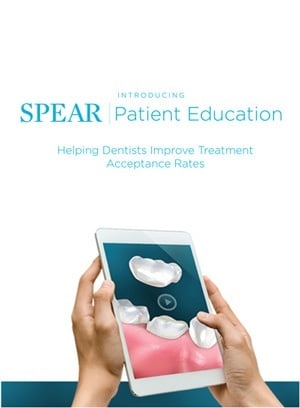 Generally for me, all complex cases start with a diagnostic wax-up. Once this wax-up is done, I can base my preparations and provisionals off of this diagnostic wax-up by using both reduction guides and provisional matrices. The difficulty is the more teeth that are involved in the diagnostic wax-up, the bigger the risk of losing solid stops for these guides and matrices. If this happens, big trouble can sneak up on you fast.
Generally for me, all complex cases start with a diagnostic wax-up. Once this wax-up is done, I can base my preparations and provisionals off of this diagnostic wax-up by using both reduction guides and provisional matrices. The difficulty is the more teeth that are involved in the diagnostic wax-up, the bigger the risk of losing solid stops for these guides and matrices. If this happens, big trouble can sneak up on you fast.
In this article, I would like to share a technique to virtually eliminate the risk of this happening with even the largest cases. Let’s use the mother of all large cases, a full mouth reconstruction. And let’s assume you are making changes in the occlusion where you need to get the patient into full mouth provisionals. Of course, the key is having a great diagnostic wax-up that you can base these provisionals off of but how do you get the wax-up off the models and into the mouth as provisonals accurately?
Diagnostic Wax-Ups and Facially Generated Treatment Planning
For me, it all comes back to our Facially Generated Treatment Planning (FGTP) basics. We complete our wax-up in segments by first getting our maxillary central incisors waxed where we want them, then we complete the remaining maxillary and mandibular anteriors. Once this is done stop and duplicate the models as shown in Figure 1.

Once this is done, we go back to the wax-up and complete the posteriors and duplicate the final wax-up in stone as you see in Figure 2. Now you will be left with two sets of stone models as you see in Figure 3.

One set will be of the desired changes for the maxillary and mandibular anteriors only, and one set will be of the desired changes for the entire mouth. The next step is to make two sets of matrices and guides; one set of the models with anterior only changes and one set with the full mouth changes. Once this is done, you treat the anterior areas first – making sure to not change the posterior segments – and get your provisionals in place by using the guides and matrices made on the anterior only models. This will allow you to use the unchanged posteriors to indices. Once your anterior provisionals are in place, you can then start with the posterior teeth and use the guides and matrices made off the full diagnostic wax-up by indexing them off your anterior provisionals which are a copy of your diagnostic wax-up.
FREE WHITEPAPER:
Helping Dentists Improve
Treatment Acceptance Rates
So how does a dentist better communicate a procedure to his or her patient? Diagnostic wax-ups, verbal explanations, pamphlets and pictures each serve a function, but Spear found what reaches patients best.
DOWNLOAD HERE